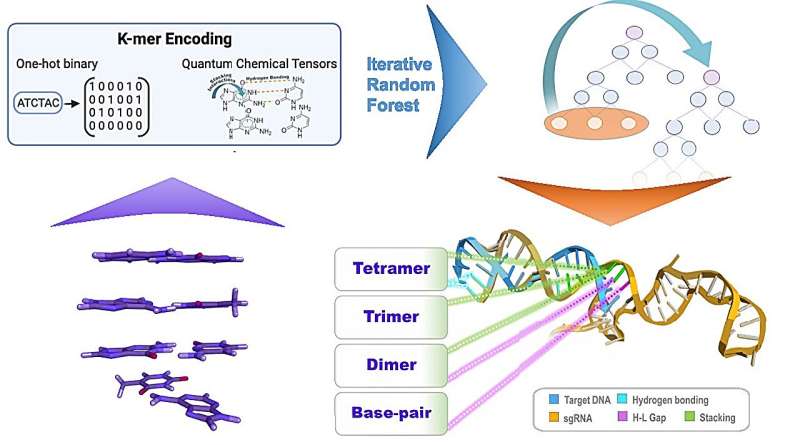This article has been reviewed according to Science X's editorial process and policies. Editors have highlighted the following attributes while ensuring the content's credibility:
fact-checked
peer-reviewed publication
trusted source
proofread
Scientists use quantum biology, AI to sharpen genome editing tool

Scientists at Oak Ridge National Laboratory have used their expertise in quantum biology, artificial intelligence and bioengineering to improve how CRISPR Cas9 genome editing tools work on organisms like microbes that can be modified to produce renewable fuels and chemicals.
CRISPR is a powerful tool for bioengineering, used to modify genetic code to improve an organism's performance or to correct mutations. The CRISPR Cas9 tool relies on a single, unique guide RNA that directs the Cas9 enzyme to bind with and cleave the corresponding targeted site in the genome.
Existing models to computationally predict effective guide RNAs for CRISPR tools were built on data from only a few model species, with weak, inconsistent efficiency when applied to microbes.
"A lot of the CRISPR tools have been developed for mammalian cells, fruit flies or other model species. Few have been geared towards microbes where the chromosomal structures and sizes are very different," said Carrie Eckert, leader of the Synthetic Biology group at ORNL. "We had observed that models for designing the CRISPR Cas9 machinery behave differently when working with microbes, and this research validates what we'd known anecdotally."
To improve the modeling and design of guide RNA, the ORNL scientists sought a better understanding of what's going on at the most basic level in cell nuclei, where genetic material is stored. They turned to quantum biology, a field bridging molecular biology and quantum chemistry that investigates the effects that electronic structure can have on the chemical properties and interactions of nucleotides, the molecules that form the building blocks of DNA and RNA.
The way electrons are distributed in the molecule influences reactivity and conformational stability, including the likelihood that the Cas9 enzyme-guide RNA complex will effectively bind with the microbe's DNA, said Erica Prates, computational systems biologist at ORNL.
The best guide through a forest of decisions
The scientists built an explainable artificial intelligence model called iterative random forest. They trained the model on a dataset of around 50,000 guide RNAs targeting the genome of E. coli bacteria while also taking into account quantum chemical properties, in an approach described in the journal Nucleic Acids Research.
The model revealed key features about nucleotides that can enable the selection of better guide RNAs. "The model helped us identify clues about the molecular mechanisms that underpin the efficiency of our guide RNAs," Prates said, "giving us a rich library of molecular information that can help us improve CRISPR technology."
ORNL researchers validated the explainable AI model by conducting CRISPR Cas9 cutting experiments on E. coli with a large group of guides selected by the model.
Using explainable AI gave scientists an understanding of the biological mechanisms that drove results, rather than a deep learning model rooted in a "black box" algorithm that lacks interpretability, said Jaclyn Noshay, a former ORNL computational systems biologist who is first author on the paper.
"We wanted to improve our understanding of guide design rules for optimal cutting efficiency with a microbial species focus given knowledge of the incompatibility of models trained across [biological] kingdoms," Noshay said.
The explainable AI model, with its thousands of features and iterative nature, was trained using the Summit supercomputer at ORNL's Oak Ridge Leadership Computer Facility, or OLCF, a DOE Office of Science user facility.
Eckert said her synthetic biology team plans to work with computational science colleagues at ORNL to take what they've learned with the new microbial CRISPR Cas9 model and improve it further using data from lab experiments or a variety of microbial species.
Better CRISPR Cas9 tools for every species
Taking quantum properties into consideration opens the door to Cas9 guide improvements for every species. "This paper even has implications across the human scale," Eckert said. "If you're looking at any sort of drug development, for instance, where you're using CRISPR to target a specific region of the genome, you must have the most accurate model to predict those guides."
Refining CRISPR Cas9 models gives scientists a higher-throughput pipeline to link genotype to phenotype, or genes to physical traits, a field known as functional genomics. The research has implications for the work of the ORNL-led Center for Bioenergy Innovation (CBI), for example, to improve bioenergy feedstock plants and bacterial fermentation of biomass.
"We're greatly improving our predictions of guide RNA with this research," Eckert said. "The better we understand the biological processes at play and the more data we can feed into our predictions, the better our targets will be, improving the precision and speed of our research."
"A major goal of our research is to improve the ability to predictively modify the DNA of more organisms using CRISPR tools. This study represents an exciting advancement toward understanding how we can avoid making costly 'typos' in an organism's genetic code," said ORNL's Paul Abraham, a bioanalytical chemist who leads the DOE Genomic Science Program's Secure Ecosystem Engineering and Design Science Focus Area, or SEED SFA.
"I am eager to learn how much more these predictions can improve as we generate additional training data and continue to leverage explainable AI modeling."
More information: Jaclyn M Noshay et al, Quantum biological insights into CRISPR-Cas9 sgRNA efficiency from explainable-AI driven feature engineering, Nucleic Acids Research (2023). DOI: 10.1093/nar/gkad736
Journal information: Nucleic Acids Research
Provided by Oak Ridge National Laboratory




















